Michael Silitch
(Editor’s note: Michael submitted this guest blog just before our Denali trip. I tried to get it published but couldn’t quite do it. I felt bad about that, as if we’d published this back in May the timing for ordering Gignoux boots would have been better. But we do the best we can. Apologies to Michael for the delay. Sometimes I need to clone myself… At any rate, here it is, a guest blog regarding Pierre Gignoux XP 444 boot, and three other PG innovations including the Carbon Fiber Binding.)
Why make a ski boot out of carbon fiber? The obvious answer is to save weight and increase rigidity. Another reason, one that first attracted me to the Pierre Gignoux XP 500 alpine touring boot three years ago (besides the weight savings), was how incredibly sexy they looked!
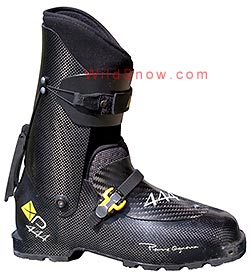
For the price, they better look good!
Formula 1 racing, sailing, cycling, and many other sports use carbon fiber; even in skiing, you see it in ski poles and skis, so why not ski boots? Carbon fiber is high-tech, expensive, fast, strong, light, black, shiny and super cool looking. So if you are fond of your carbon fiber bicycle’s aesthetics, you might really enjoy a pair of the new XP 444’s.
It took a ski mountaineering race champion with a degree in biomechanical engineering to make the idea real. At the end of his illustrious ski mo career (wins in the Pierra Menta, European Championships, and a record up and down Mont Blanc), Pierre started tinkering with boots. His first all carbon fiber ski boot was released to the public in 2006, weighing half that of the existing race boots.
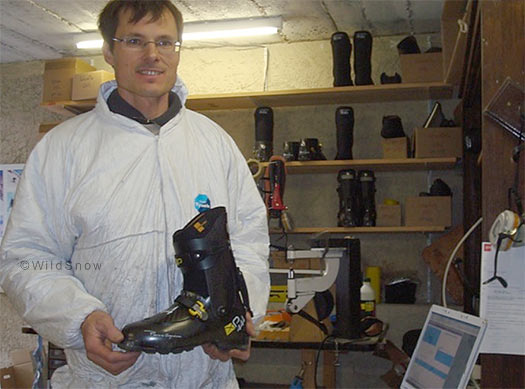
Pierre Gignoux is passionate about ski mountaineering and ski mo equipment. Here in his workshop displaying his XP 444
I bought my first pair of Pierre Gignoux boots in 2008 and have skied in this same pair for three seasons. I love the boot for racing, race training and ski touring. The old adage of a pound on the foot is like five in the pack is most certainly applicable when it comes to ski touring. With a lightweight boot and ski I feel so much more free and fast going uphill.
Not only does the weight savings make skinning much easier, it also puts less pressure on your feet–I feel so much more comfortable in the boot after a long day and never get blisters with these ultra light boots. The freedom of movement is also amazing; it’s almost like nordic skiing.
My wife, Nina, started ski mo racing in 2005 at an uphill race series in Switzerland. She was getting top ten and wanted lightweight race gear. I gave her a goal of five races first, and once she fulfilled that, we bought her the gear and she was instantly on the podium!
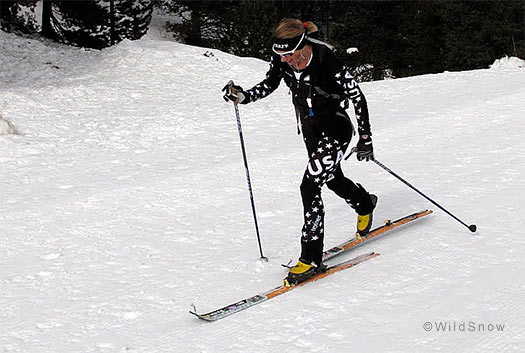
Nina at the 2010 World Championships in Andorra, Vertical Race, with her XP 500's
Nina is now a World Cup racer (7th overall in 2010) and she’s been on her PG’s for the last 3 seasons; this year she bought the new and improved XP 444. Her favorite things about the boots are their weight and edge control. Nina has racing experience in both alpine (high school) and nordic (college), so I respect her opinion a lot. She just finished the Patrouille des Glaciers Race from Zermatt to Verbier and she and her team had some of the fastest downhill splits of any women’s team.
So, maybe you’re convinced that light is good, but you’re wondering about downhill performance. Well, again, these boots shine. An all carbon boot gives you great stiffness and edge precision (I’ve heard that alpine racing boot companies have been experimenting with a carbon fiber boot). The Pierre Gignouxs have more rigidity than most ski touring boots, let alone other ski mo race boots.
The Gignoux locking lever is also super effective. Snap it up or down with one hand, you either lock and tighten the boot for downhill or open and loosen the boot for uphill. This is a real time savings in racing and a great convenience for long tours where the transitions become difficult and time consuming, fiddling with the buckles, powerstraps and levers each time you put your skins on or take them off. All other brands have copied this one motion style in some form or another, but in my experience Gignoux’s is the simplest and easiest to use.
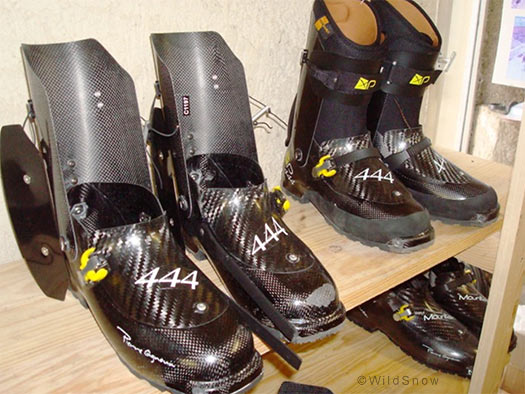
Boots in the workshop. Here you see an example of the rubber rand for the XP Mountain.
Even in the all carbon game, the Pierre Gignoux boots stand out as the lightest and the most race tested. The XP 444 in size 27.5 with a “bikini” liner weighs in at 550 grams (and Nina’s in 24.5 weighs 500g) whereas other carbon boots we’ve checked out have an actual weight of about 780g in 27.5. The XP 444 is lower profile than most boots including the old XP 500’s, so you get a more precise fit inside the boot and less ankle bumping and lycra suit ripping on the outside. (Pierre works closely with Palau and has created one of the lightest and most comfortable thermoformable liners.)
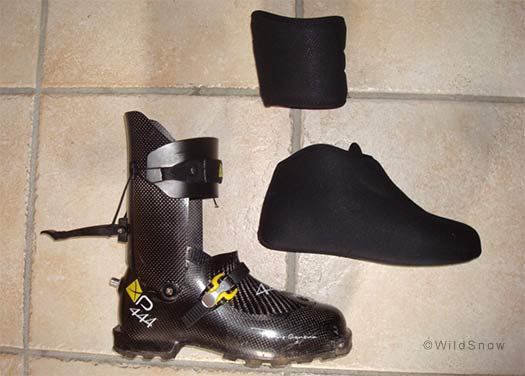
4 Big Innovations in ultra light ski mo boots: 1. The all carbon boot 2. The integrated one movement latching/cinching lever. 3. The bikini inner boot for flexibility and weight savings. 4. Too hot to show you, but really cool--the carbon fiber ski binding.
Back to the carbon boot for ski touring. It was tough to convince Nina to make the switch from telemark to alpine touring when we moved to Chamonix in 2001, but now it’s even tougher to get her back on “heavy metal” skis and boots. Whether we’re skiing the famous off piste Vallee Blanche run (10,000 ft of vertical over 10 miles), doing a multi-day ski tour, or a more technical ski mountaineering summit, she’ll always choose her Ski Trab World Cup skis (96-64-78mm), her ATK Race bindings, and her Pierre Gignoux XP 444 boots (Incidentally, this set-up weighs: 1 Trab WC 157 cm +ATK Race = 865 grams + 1 XP 444 and bikini liner= 1415g per foot. Isn’t that whole setup lighter than most plastic ski touring boots?
As far as durability goes, the Pierre Gignoux boots have been fine. They may be a little less durable than some of their plastic counterparts as I’ve heard of several problems, but I know that Pierre Gignoux will take care of anything quickly and easily (easily done in Europe, but would require shipping the boots if you live over the pond, which is perhaps the biggest downside to ownership if you don’t live in Europe).
The XP Mountain is a good solution for those who want a slightly beefier boot for the mountains but still want incredible weight savings and rigidity. It’s basically the same as the XP 444 except for a true Vibram sole and a rubber rand to protect from scratches. Stephan Brosse, a French former racer (world champion) has transformed into an extreme skier and skis the steep faces and chutes of the Alps in the XP Mountains.
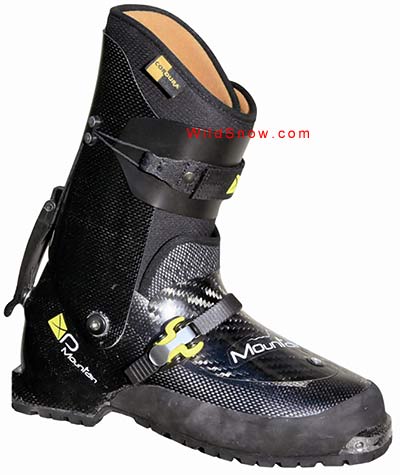
A stock photo of the XP Mountain. A good choice as an all purpose touring boot, as the rubber rand prevents damage to the carbon fiber.
(A note about price and ordering: Yes, another downside of this boot is the price, which at over twice the average retail for AT boots can seem somewhat stratospheric. But when you realize these are basically hand made craft items that have a weight/performance ratio far exceeding perhaps any other ski boot out there, the price actually seems pretty reasonable. Note that Pierre has a waiting list as long as six months, so order with plenty of lead time.)
In the more cool stuff department: Pierre said I could let the cat out of the bag on his latest top secret project: a new race binding, thinking totally out of the box! This binding does not rely on the standard Dynafit solution to hold the toe in place, but uses the same fittings. I had heard of it being tested by several athletes during the Pierra Menta and when Kilian Jornet came for a visit on his way up Mont Blanc, I asked him about them. They weigh next to nothing and the toe works with a carbon fiber “spring”, a similar concept to new Look road racing bicycle pedal, the Keo Blade.
Once these new bindings are ready for prime time, they will make getting in and out of your bindings simpler, easier and quicker, plus they’ll save you a ton of weight.
The carbon fiber boot, one motion heel lock/buckle tightening, the ultralight two-piece bikini inner boot, and now a carbon race binding. What more can this man come up with?
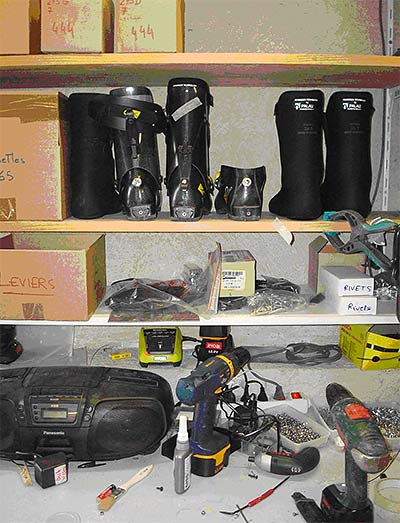
Gignoux's workshop is full of bits and pieces as he is always tinkering to find the best solutions with hardware, etc.
(WildSnow guest blogger Michael Silitch lives in Chamonix, France with his wife Nina. Michael works as a guide, check out his website.)
Beyond our regular guest bloggers who have their own profiles, some of our one-timers end up being categorized under this generic profile. Once they do a few posts, we build a category. In any case, we sure appreciate ALL the WildSnow guest bloggers!
